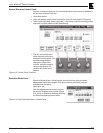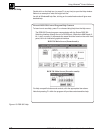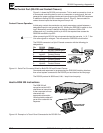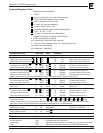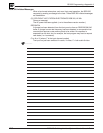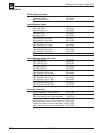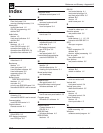
Reference and Glossary • Appendix B
RGB 320 Switching Interface System • User’s Manual • Extron
Luminance –
The photometric radiance of a light source. The signal that represents brightness
in a video picture. Luminance is any value between black and white. Luminance is
abbreviated as
Y.
Also see
chrominance.
MHz –
Megahertz. One million cycles per second.
NTSC –
National Television Standards Committee. The television standard, for North
America and parts of South America, having 525 lines/60 Hz (60 Hz refresh). Two
fields per frame and 30 frames per second.
Output –
The product of an operation by a device going to some external destination, such
as another device, a video screen, image or hard copy.
PAL –
Phase Alternate Line. The phase of the color carrier is alternated from line to line.
It takes four full pictures for the color to horizontal phase relationship to return to
the reference point. This alternation helps cancel phase errors. For this reason,
the hue control is not needed on a PAL TV set. PAL, in many forms, is used in
Australia, England, Scandinavia, South Africa and Western Europe. PAL uses a
625-line, 50-field composite color transmission system.
Peak-to-peak –
p-p. The amplitude (voltage, for example) difference between the most positive
and the most negative excursions (peaks) of a signal.
Peaking –
A means of compensating for mid and high frequency RGB video bandwidth
response in data monitors and projectors, and for signal losses due to cable
capacitance. The higher the frequency and the greater the cable length, the more
peaking may be required.
Phantom power –
Power supplied to a microphone using the shield of a balanced audio connection.
Microphones using phantom power must be condenser style microphones
designed for use with phantom power systems. Damage can result to other types
of audio components from the improper use of phantom power.
Pin out –
An illustration or table that names signals, voltages, etc. that are on each pin of a
connector or cable.
Plenum cable –
Cable having a covering that meets the UL specifications for resistance to fire.
PLUGE –
Picture line up generation equipment. The name of a test pattern that assists in
properly setting picture black level. PLUGE can be part of many test patterns. The
phrase and origination of the test signal are both credited to the BBC.
Power (electrical) –
The dissipation of heat by passing a current through a resistance. Measured in
Watts (W), it is expressed by Ohm’s law from the three variables: Voltage (E) and
Current (I) and Resistance (R), i.e., P = I
2
xR, or, P = E
2
/R or P = ExI.
Resolution –
The density of lines or dots for a given area that make up an image. Resolution
determines the detail and quality in the image. A measure of the ability of a
camera or video system to reproduce detail. A measure of the amount of detail
that can be seen in an image. Often expressed as a number of pixels, but more
correctly it is the bandwidth. We say that a sharp, clear picture has high
resolution.
RGB –
Red, green, blue. The chrominance information in a video signal. The basic
components of the color television system. They are also the primary colors of
light in the additive color process.
RGB video –
A form of color video signal (red, green, blue) distinctly different from the
composite color video used in standard television sets. RGB can be displayed
only on an RGB monitor, which has a separate electron gun for each of these
primary colors. Some color television sets use only one gun. RGB monitors are
noted for their crisp, bright colors and high resolution.
B-5



